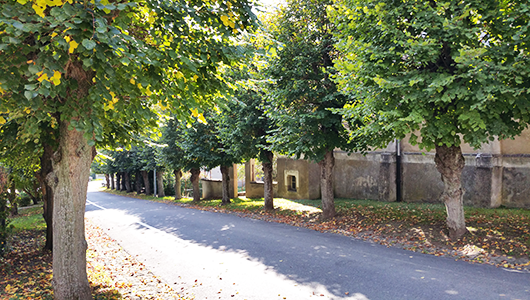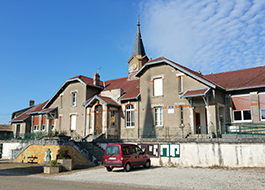Eply
Durée visite : 30 minutes
Moyen : Pédestre
On trouve des traces d’occupation aux époques protohistorique, gallo-romaine et franque. Le village d’Éply était domaine spirituel et temporel des évêques de Metz. De par sa position géographique, Éply est un village frontière. En 1914, la commune subit dès les premiers jours de guerre l’insécurité par l’ennemi allemand. Une petite partie des habitants fuit rapidement. Durant les combats violents qui s’ensuivent, le village est ravagé. Éply est occupé principalement par le Landwehr Infanterie Regiment 68. De nombreux documents photographiques en témoignent. Les Français se trouvaient sur l’autre rive de la Seille, à Morville et Port-sur-Seille notamment. Un point d’eau, situé à proximité de la commune, permettait aux Allemands et Français de se désaltérer. Parmi les habitants mobilisés, 34 meurent au combat. On dénombre aussi 3 victimes civiles. Le village est pratiquement détruit. Beaucoup d’habitants ne reviennent pas après la guerre : on compte 508 habitants en 1911, et seulement 374 en 1921. La guerre terminée, l’État fait construire des baraques en bois. Elles servent à héberger les habitants revenus au village libéré. L’entreprise Chabanne de Paris reconstruit le village. Le tracé des rues a été modifié à cette occasion. L’école est reconstruite grâce aux aides américaines.
We find traces of occupation in the protohistoric, Gallo-Roman and Frankish eras. The village of Éply was the spiritual and temporal domain of the bishops of Metz. Due to its geographical position, Éply is a border village. In 1914, the town suffered from the first days of the war insecurity by the German enemy. A small part of the inhabitants flee quickly. During the violent fighting that ensued, the village was devastated. Éply is mainly occupied by the Landwehr Infanterie Regiment 68. Numerous photographic documents bear witness to this. The French were on the other bank of the Seille, in Morville and Port-sur-Seille in particular. A water point, located near the town, allowed the Germans and French to quench their thirst. Among the inhabitants mobilized, 34 died in combat. There are also 3 civilian victims. The village is practically destroyed. Many inhabitants did not return after the war: there were 508 inhabitants in 1911, and only 374 in 1921. When the war was over, the state built wooden barracks. They are used to accommodate the inhabitants returning to the liberated village. The Chabanne company in Paris is rebuilding the village. The street layout was changed on this occasion. The school is rebuilt thanks to American aid.
Wir finden Spuren der Besetzung in der protohistorischen, galloromanischen und fränkischen Zeit. Das Dorf Éply war die geistige und zeitliche Domäne der Bischöfe von Metz. Aufgrund seiner geografischen Lage ist Éply ein Grenzdorf. 1914 litt die Stadt unter den ersten Tagen der Kriegsunsicherheit des deutschen Feindes. Ein kleiner Teil der Einwohner flieht schnell. Während der darauf folgenden gewaltsamen Kämpfe wurde das Dorf zerstört. Éply ist hauptsächlich vom Landwehr Infanterie Regiment 68 besetzt. Zahlreiche fotografische Dokumente zeugen davon. Die Franzosen befanden sich am anderen Ufer der Seille, insbesondere in Morville und Port-sur-Seille. Ein Wasserpunkt in der Nähe der Stadt ermöglichte es den Deutschen und Franzosen, ihren Durst zu stillen. Unter den mobilisierten Einwohnern starben 34 im Kampf. Es gibt auch 3 zivile Opfer. Das Dorf ist praktisch zerstört. Viele Einwohner kehrten nach dem Krieg nicht zurück: 1911 gab es 508 Einwohner und 1921 nur 374. Nach Kriegsende baute der Staat Holzbaracken. Sie werden verwendet, um die Bewohner aufzunehmen, die in das befreite Dorf zurückkehren. Die Firma Chabanne in Paris baut das Dorf wieder auf. Das Straßenlayout wurde bei dieser Gelegenheit geändert. Die Schule wird dank amerikanischer Hilfe wieder aufgebaut.

D’or à trois pals d’azur à la bande de gueules chargée de trois alérions d’argent. La bande et les pals accompagnés en chef de deux tours de gueules et en pointe de deux arbres de sinople fûtés de gueules.
Eply, terre lorraine, a trois rivières, représentées par les pals, deux tours et un bois symbolisé par les arbres. Ce blason est utilisé depuis 1976.
Or, three pals Azure, a bend Gules charged with three alerions Argent. The band and the pals accompanied in chief by two turns Gules and in base of two trees Vert barred Gules.
Eply, land of Lorraine, has three rivers, represented by the pals, two towers and a wood symbolized by the trees. This coat of arms has been in use since 1976.
Oder drei Kumpels Azure a bend Gules mit drei Alerionen Argent aufgeladen. Die Band und die Kumpels begleiteten hauptsächlich zwei Umdrehungen Gules und in der Basis von zwei Bäumen Vert Barred Gules.
Eply, Land Lothringen, hat drei Flüsse, dargestellt durch die Kumpels, zwei Türme und einen Wald, der durch die Bäume symbolisiert wird. Dieses Wappen wird seit 1976 verwendet.

Les habitants et les habitantes de Eply s’appellent les Espliens et les Espliennes.
The inhabitants of Eply are called the Espliens and the Espliennes.
Die Einwohner von Eply heißen Espliens und Espliennes.
Les points de visites
.
Ce bel édifice élancé a été reconstruit après les dommages le la Grande Guerre. Il abrite une statue de son saint éponyme. Les vitraux sont modernes. On peut admirer devant l’église le monument aux morts. Il est surmonté d’un Poilu.
Christophe de Lycie est plus connu comme saint Christophe. Sa fête se situe le 25 juillet. Il est considéré comme le patron des voyageurs. Christophe dérive des mots grecs Khristos (Christ) et phorein (porter), c’est-à-dire celui qui porte le Christ. C’est une allusion à un géant légendaire initialement nommé Réprouvé. Celui-ci aurait aidé l’enfant Jésus à traverser une rivière. Autrefois il passait pour mettre à l’abri des maladies quiconque voyait sa statue. La légende a des antécédents païens très anciens. Georges Dumézil écrit que le Mahabharata indien mentionne un géant semblable. Il fait de la même façon traverser le Gange a un enfant roi.
This beautiful, slender building was rebuilt after damage during the Great War. It houses a statue of its eponymous saint. The stained glass windows are modern. You can admire the war memorial in front of the church. It is surmounted by a Hairy.
Christopher of Lycia is better known as Saint Christopher. His feast is on July 25. He is considered the patron saint of travelers. Christophe derives from the Greek words Khristos (Christ) and phorein (to carry), that is to say the one who carries Christ. It’s an allusion to a legendary giant originally named Forsaken. This one would have helped the baby Jesus to cross a river. Formerly he was considered to protect anyone who saw his statue from disease. The legend has a very ancient pagan history. Georges Dumézil writes that the Indian Mahabharata mentions a similar giant. In the same way, he crosses the Ganges with a child king.
Dieses schöne, schlanke Gebäude wurde nach Schäden während des Ersten Weltkriegs wieder aufgebaut. Es beherbergt eine Statue seines gleichnamigen Heiligen. Die Glasfenster sind modern. Sie können das Denkmal für die Toten vor der Kirche bewundern. Es wird von einem Haarigen überragt.
Christopher von Lykien ist besser bekannt als Saint Christopher. Sein Fest ist am 25. Juli. Er gilt als Schutzpatron der Reisenden. Christophe leitet sich von den griechischen Wörtern Khristos (Christus) und Phorein (tragen) ab, dh derjenige, der Christus trägt. Es ist eine Anspielung auf einen legendären Riesen namens Forsaken. Dieser hätte dem Jesuskind geholfen, einen Fluss zu überqueren. Früher galt er als Schutz für jeden, der seine Statue vor Krankheiten sah. Die Legende hat eine sehr alte heidnische Geschichte. Georges Dumézil schreibt, dass der indische Mahabharata einen ähnlichen Riesen erwähnt. Ebenso überquert er mit einem Kinderkönig den Ganges.
.
.
En 1881, les lois Ferry rendent l’enseignement primaire gratuit et obligatoire jusqu’à 13 ans. Les communes reçoivent aussi l’obligation de se doter d’une école publique laïque. Dans beaucoup de communes, on construit un local municipal qui est à la fois mairie et école. La forme la plus répandue est la mairie dans un corps central. Dans des ailes symétriques se situent l’école des filles et l’école des garçons. Peuvent s’y ajouter des logements de fonction pour les instituteurs et institutrices. Le fronton de la mairie porte souvent mention de la devise de la République : Liberté, Egalité, Fraternité. La figure de Marianne, allégorie de la République, est présente à l’extérieur ou à l’intérieur des mairies. Ces ensembles ajoutent au caractère monumental des hôtels de ville. Ils affirment la présence de la République sur le territoire national. Avec les écoles-mairie la République s’implante dans les campagnes. L’école incarne la politique d’instruction de la IIIe République. C’est à la mairie et à l’école que se fait l’éducation des citoyens. La fréquentation des ensembles mairie-école familiarise les milieux ruraux à la démocratie. Et l’idée républicaine se répand.
In 1881, the Ferry Laws made primary education free and compulsory for up to 13 years of age. The municipalities also receive the obligation to have a secular public school. In many municipalities, municipal premises are being built which is both town hall and school. The most common form is the town hall in a central body. In symmetrical wings are the girls ‘school and the boys’ school. There may be additional official accommodation for teachers. The pediment of the town hall often bears mention of the motto of the Republic: Liberty, Equality, Fraternity. The figure of Marianne, allegory of the Republic, is present outside or inside town halls. These sets add to the monumental character of town halls. They affirm the presence of the Republic on the national territory. With the town hall schools, the Republic is establishing itself in the countryside. The school embodies the education policy of the Third Republic. It is in the town hall and in the school that the education of the citizens takes place. Attendance at town hall-school complexes familiarizes rural areas with democracy. And the Republican idea is spreading.
Im Jahr 1881 machten die Fährgesetze die Grundschulbildung für Kinder bis zu 13 Jahren kostenlos und obligatorisch. Die Gemeinden müssen auch eine weltliche öffentliche Schule haben. In vielen Gemeinden werden kommunale Räumlichkeiten gebaut, die sowohl Rathaus als auch Schule sind. Die häufigste Form ist das Rathaus in einem zentralen Körper. In symmetrischen Flügeln befinden sich die Mädchen- und die Jungenschule. Es kann zusätzliche offizielle Unterkünfte für Lehrer geben. Auf dem Giebel des Rathauses wird häufig das Motto der Republik erwähnt: Freiheit, Gleichheit, Brüderlichkeit. Die Figur von Marianne, Allegorie der Republik, ist außerhalb oder innerhalb der Rathäuser präsent. Diese Sets tragen zum monumentalen Charakter der Rathäuser bei. Sie bekräftigen die Präsenz der Republik auf dem Staatsgebiet. Mit den Rathausschulen etabliert sich die Republik auf dem Land. Die Schule verkörpert die Bildungspolitik der Dritten Republik. Im Rathaus und in der Schule findet die Erziehung der Bürger statt. Der Besuch von Rathaus-Schulkomplexen macht ländliche Gebiete mit Demokratie vertraut. Und die republikanische Idee verbreitet sich.







